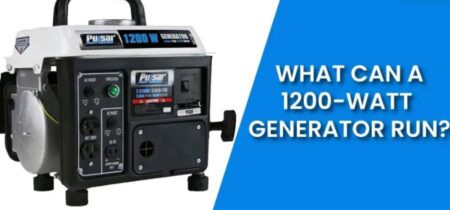
Let’s all agree that power outages occur at the most unwanted times and are pretty unpredictable. They can happen for any reason, from severe weather to equipment failures. When the power goes out, it can be inconvenient and even dangerous. But there’s no need to panic.
With a generator, you can keep your lights on, your food cold, and your family safe. In this blog post, we’ll show you how you can effectively and safely use a generator during a power outage.
How to Select the Right Generator for Your Needs?
Pick the right generator type according to your requirement
Selecting the right generator for your needs is crucial to ensure that you have adequate backup power during an outage. There are two main types of generators to consider: portable and standby generators.
- Portable Generators: Portable generators are smaller, more affordable, and can be easily transported to different locations as needed. They typically run on gasoline, propane, or diesel fuel, and their power output ranges from 1,000 to 10,000 watts.
This makes them suitable for powering essential appliances like refrigerators, lights, and small electronics during a power outage. However, they require manual setup and fuel refilling, which can be inconvenient during extended outages. One popular example is the Honda EU2200i, which produces 2,200 watts and is known for its quiet operation and fuel efficiency.
- Standby Generators: Standby generators, on the other hand, are permanently installed outside your home or business and automatically switch on when the power goes out. They are larger and more powerful, with output capacities ranging from 5,000 to 25,000 watts or more.
Standby generators typically run on natural gas or propane and can provide continuous power to your entire property for days, depending on their fuel supply. However, they are more expensive and require professional installation. A well-known example is the Generac Guardian Series, which offers various models with power outputs ranging from 9,000 to 24,000 watts.
Consider these factors when buying a generator
- Power output: It is crucial to determine the total wattage required by the appliances and devices you plan to power during an outage. Add up the starting and running watts of each item to ensure your generator can handle the load.
Remember that some appliances, like air conditioners and refrigerators, have a higher starting wattage than their running wattage. For example, if your total power need is around 5,000 watts, consider a generator with an output capacity of at least 6,000 watts to account for fluctuations and avoid overloading.
- Fuel type: Generators can run on gasoline, diesel, propane, or natural gas. Each fuel type has its pros and cons. Gasoline is widely available but has a shorter shelf life and may require stabilizers for long-term storage.
Diesel is more energy-dense and efficient but can be more expensive. Propane has a longer shelf life and burns cleaner, while natural gas is a convenient option for standby generators as it is supplied through utility lines. Consider fuel availability, storage requirements, and environmental impact when making your choice.
- Noise level: Generators can be quite noisy, with some models producing sound levels of 60 to 80 decibels or more. This can be a concern in residential areas or if you plan to use the generator during nighttime hours. Look for generators with noise-reducing features, such as mufflers or soundproof enclosures. Some portable inverter generators are known for their quiet operation, with noise levels as low as 50 decibels.
- Price: Generators can range in price from a few hundred dollars for small portable models to several thousand dollars for large standby units. While it may be tempting to opt for the cheapest option, it is essential to consider the long-term value of your investment.
Taking the time to research and weigh these factors will help you choose a generator that best meets your specific needs and provides reliable backup power during a power outage.
Can You Use a Generator Without Electricity?
No, it’s not possible to use a generator during a power outage, especially without electricity. Generators are designed to provide electricity when there is no access to the main power grid, making them an ideal backup power source during outages. The concept of generators as a power source relies on their ability to convert mechanical energy into electrical energy, which can be used to power various appliances and devices.
The process of generating electricity begins when the generator’s internal combustion engine burns fuel, such as gasoline, diesel, propane, or natural gas. This combustion produces mechanical energy in the form of a rotating shaft, which drives an alternator.
The alternator is responsible for converting mechanical energy into electrical energy in the form of alternating current (AC) power. This electricity is then channeled through outlets or a transfer switch to power your home or business.
Fuel plays a critical role in operating a generator, as it is the primary energy source that drives the engine. The generator’s power output and runtime depend on the amount and type of fuel used, with some fuels providing more energy-dense and efficient power generation than others. It is essential to maintain an adequate supply of fuel and follow the manufacturer’s guidelines for fuel storage and use to ensure your generator operates efficiently and safely during a power outage.
How to Set up Your Generator Safely?
Setting up and operating your generator safely is crucial to avoid accidents and ensure reliable performance during a power outage. Here are some essential guidelines to follow:
- Proper location and ventilation: Place your generator on a level, sturdy surface in a well-ventilated area, preferably outside and away from windows, doors, and vents. This helps prevent the buildup of deadly carbon monoxide gas produced by the generator’s engine. The Consumer Product Safety Commission recommends maintaining a minimum distance of 20 feet between your generator and your home or any occupied spaces.
- Using the right extension cords and power strips: Select heavy-duty, outdoor-rated extension cords that can handle the wattage of your connected appliances. Ensure cords are free of cuts or damage and are not tangled or covered. Use power strips with built-in circuit breakers to prevent overloading and potential fire hazards.
- Grounding your generator: Some generators require grounding to prevent electrical shocks and minimize the risk of electrocution. Follow the manufacturer’s instructions for proper grounding procedures, which may include connecting the generator to a grounding rod or another approved grounding method.
- Regular maintenance and safety checks: To keep your generator running efficiently and safely, perform routine maintenance as recommended by the manufacturer. This may include checking oil and fuel levels, cleaning air filters, and inspecting components for wear and damage. Test your generator periodically to ensure it starts and operates correctly, and familiarize yourself with its features and safety precautions.
By following these guidelines, you can help ensure that your generator is set up and operated safely, providing you with a reliable source of backup power during an outage while minimizing potential risks.
How to Set up Your Generator Safely?
The length of time you should run your generator during a power outage depends on the specific generator you possess. On average, a standby generator can operate for up to 3,000 hours, while a typical portable generator has a runtime of around 8 hours. However, running a generator continuously for more than 500 hours is not advised, as it may result in engine damage. To guarantee optimal performance during power outages, it is crucial to maintain and service your generator monthly.
Do You Have to Turn Off Your Main Breaker When Using a Generator?
Yes, it is important to turn off your main breaker when using a generator. This will help to prevent back feeding, which is a dangerous condition that can occur when electricity from the generator flows back into the power lines. Backfeeding can electrocute utility workers who are trying to restore power to the area.
To turn off your main breaker, locate it in your home’s electrical panel. It is usually a large, square breaker with the words “main” or “main breaker” written on it. Flip the breaker to the “off” position.
Once the main breaker is off, you can safely connect your generator to your home’s electrical system. Be sure to follow the manufacturer’s instructions when connecting the generator.
When you are finished using your generator, be sure to turn it off and disconnect it from your home’s electrical system. Then, turn the main breaker back on.
How to Use a Generator During a Power Outage?
To make the most of your generator during a power outage, it’s essential to use it efficiently and effectively. Here are some practical tips to help you maximize your generator’s performance and extend its runtime:
- Prioritize essential appliances and devices: Focus on powering the most critical appliances and devices in your home or business, such as refrigerators, freezers, lights, and essential medical equipment. By limiting the number of items connected to the generator, you can reduce the overall load and conserve fuel.
- Conserving fuel and energy: To prolong your generator’s runtime and save fuel, consider implementing energy-saving measures during a power outage. Turn off or unplug devices and appliances that are not in use, and avoid opening refrigerator and freezer doors unnecessarily to retain cold air. You can also use energy-efficient lighting options, such as LED bulbs, to reduce power consumption.
- Schedule generator use: If you have a portable generator with limited runtime, consider creating a schedule to power specific appliances and devices in intervals rather than continuously. For example, you could alternate between powering the refrigerator and air conditioner, or designate specific times for charging electronics. This approach can help you extend the generator’s runtime and ensure your most critical needs are met throughout the power outage.
How to Use a Generator During a Power Outage Conclusion
Generators serve as a valuable backup power source during power outages, helping to maintain normalcy and safety in our daily lives. Throughout this guide, we’ve discussed essential topics such as choosing the right generator based on your needs, understanding how generators function without electricity, setting up and operating your generator safely, and using it efficiently during a power outage.
It’s important to remember that generator safety and preparedness are of utmost importance. By carefully selecting a suitable generator, following proper setup and maintenance procedures, and prioritizing the use of essential appliances and devices, you can ensure a reliable and safe source of backup power during any outage. Now that you know how to use a generator during a power outage, investing time and effort in understanding and implementing these guidelines will provide you with confidence and peace of mind knowing that you are well-prepared for any power outage that may occur.
Also Read:
How To Run a Hydrogen Power Generator to Power Your House?
What is a Small Portable Generator
How Much Does a Generac Solar Generator Cost
How to Use a Portable Generator
What type of Solar Power Generator for Home are best in 2023








